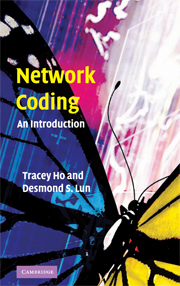6 - Security Against Adversarial Errors
Published online by Cambridge University Press: 06 July 2010
Summary
Multicast in decentralized settings, such as wireless ad hoc and peer–to–peer networks, is seen as a potential application area that can benefit from distributed network coding and its robustness to arc failures and packet losses. In such settings, packets are coded and forwarded by end hosts to other end hosts. It is thus important to consider security against compromised nodes.
Network coding presents new capabilities as well as challenges for network security. One advantage of multicast network coding is that it facilitates the use of a subgraph containing multiple paths to each sink node. Coding across multiple paths offers useful possibilities for information theoretic security against adversaries that observe or control a limited subset of arcs/transmissions in the network. By adding appropriately designed redundancy, error detection or error correction capabilities can be added to a distributed multicast scheme based on random linear network coding, as described in the following. On the other hand, coding at intermediate nodes poses a problem for traditional security techniques. For instance, coded combinations involving an erroneous packet result in more erroneous packets, so traditional error correction codes that deal with a limited proportion of erroneous packets are less effective. Also, traditional signature schemes do not allow for coding at non–trusted intermediate nodes.
- Type
- Chapter
- Information
- Network CodingAn Introduction, pp. 130 - 156Publisher: Cambridge University PressPrint publication year: 2008



